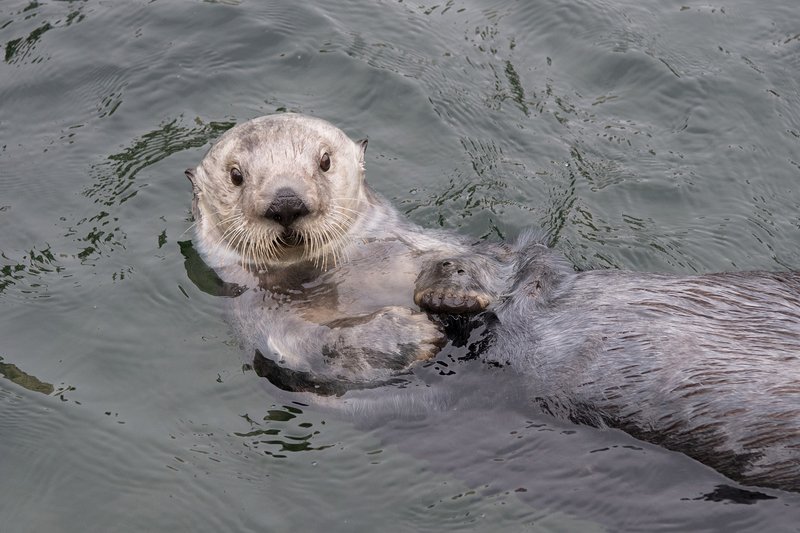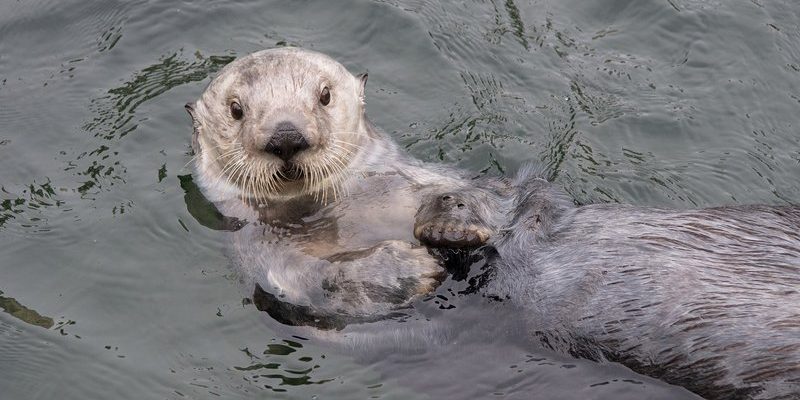
Imagine a furry little creature, floating on its back in the shimmering ocean, breaking open shellfish with a rock. That’s the sea otter for you! These playful marine mammals are not just adorable; they also play a vital role in their ecosystems. Sea otters are often seen as the “guardians of the kelp forest” because of their unique ability to maintain the balance within this underwater world.
In many ways, sea otters are like the “shepherds” of the sea. They have thick fur that keeps them warm in chilly waters, even while they hunt for food. But, their cuteness is just the tip of the iceberg. These creatures are fascinating in their behaviors, habitats, and even their diets. If you’ve ever wondered about the life of a sea otter, keep reading. You’re in for a treat!
Physical Characteristics
Sea otters are a bit like the teddy bears of the ocean. When you see them, their round faces and fluffy bodies make you want to cuddle up to them—though you definitely shouldn’t! Adult sea otters typically weigh between 50-100 pounds and can grow up to 4-5 feet long. Their luxurious fur, which is the densest in the animal kingdom, keeps them insulated against the cold waters of the Pacific Ocean. This fur can have up to a million hair follicles per square inch!
One of the most interesting features of sea otters is their dexterous paws. Unlike other marine mammals, their front paws are adapted for grasping and manipulating objects. This allows them to use tools, like rocks, to crack open shellfish. Imagine having hands that could turn into tools while you’re having lunch—it’s pretty impressive!
Additionally, sea otters have a unique coloration that can vary from light brown to dark chocolate. They often have lighter patches on their chests and faces, which helps distinguish individuals in the wild. Their tails are long and use them to aid in swimming. All these features come together to make the sea otter not just charming but also incredibly efficient in its marine habitat.
Habitat and Distribution
Sea otters are primarily found along the coasts of the North Pacific Ocean, from northern Japan to the Aleutian Islands in Alaska and down to California. They thrive in coastal waters where kelp forests flourish. These underwater jungles provide shelter and hunting grounds for sea otters, making them the perfect home. The kelp not only protects them but also offers a rich supply of food.
You might be surprised to learn that sea otters are not limited to one type of habitat. They can be found in bays, estuaries, and tidal pools. The presence of kelp beds is crucial to their survival, as they provide food sources and places to rest. One might say that these otters have a favorite restaurant and a cozy home all in one!
Unfortunately, habitat loss due to pollution, boat traffic, and climate change poses a significant threat to sea otters. As the oceans warm, the kelp forests that are so vital to their survival are at risk, putting pressure on these furry creatures. Keeping their homes healthy is essential for the future of sea otters.
Diet and Feeding Habits
Sea otters are true foodies of the ocean. Their diet mainly consists of various marine invertebrates, such as sea urchins, crabs, clams, and snails. They have been known to eat over 200 different types of prey! Think of them as the “gourmet chefs” of the marine world, constantly searching for the freshest ingredients.
What’s remarkable is how sea otters use tools to help them eat. They have learned to crack open the hard shells of sea urchins and clams using rocks. This unique behavior is not only fascinating but also essential for their feeding strategy. They’ll often keep a preferred rock tucked in a pouch of skin under their arms, ensuring they always have their “kitchen tools” handy.
In terms of daily calorie needs, sea otters require about 25-30% of their body weight in food each day, which is around 3-4 pounds of food! This high caloric need helps them maintain their energy levels and keep their thick fur warm. Seeing a sea otter floating on its back, munching on a tasty treat, is a heartwarming reminder of how playful and resourceful these animals can be.
Behavior and Social Structure
Sea otters are social creatures, often seen floating together in groups called rafts. These rafts can include anywhere from a few otters to dozens of them. When they gather in groups, they wrap themselves in kelp to keep from drifting apart, forming a cozy community. It’s like they’ve created a floating neighborhood!
Within these rafts, sea otters display a range of behaviors, from grooming to playing. They often engage in playful antics, such as sliding down rocks or chasing each other around. This playfulness isn’t just for fun; it helps strengthen social bonds within the group, making their community more cohesive. You might even find them holding paws while they sleep, reinforcing their connection.
While they are generally social, sea otters can also be territorial, especially when it comes to hunting grounds. Males may establish dominance over specific areas, ensuring they have access to food. This interesting blend of social interaction and competition makes their social structure quite dynamic.
Reproduction and Lifespan
When it comes to reproduction, sea otters have a relatively slow breeding rate. Females typically give birth to a single pup, sometimes twins, after a gestation period of about six months. These pups are born with their eyes closed and can’t dive underwater for the first few weeks after birth. This is where the mother’s role becomes incredibly important. She must keep her pup on the surface while she hunts for food.
The bond between a mother sea otter and her pup is truly heartwarming. Mothers are known to wrap their young in kelp to keep them safe while they hunt. This caring behavior allows the mother to leave her pup temporarily, knowing it will be secure. It’s a beautiful demonstration of the maternal instinct in the animal kingdom.
Sea otters typically live about 15-20 years in the wild, but some have been known to reach over 25 years in captivity. Their lifespan can be affected by various factors, including food availability, habitat conditions, and threats from predators or human activities. As such, protecting their environment is crucial to ensuring these charming creatures can thrive for generations to come.
Conservation Status
Despite their cute appearance, sea otters face numerous challenges that threaten their existence. Once nearly hunted to extinction for their fur, which was highly valued, conservation efforts have helped some populations recover. However, they are still listed as “Endangered” in many areas, and their future is uncertain.
Several factors contribute to their vulnerability, including oil spills, fishing nets, and habitat loss caused by urban development. Oil spills, in particular, pose a significant risk as they can contaminate the waters and the prey that sea otters rely on. This can lead to decreased food availability and health problems for the otters.
Conservation organizations are working tirelessly to protect sea otters and their habitats. Rehabilitation programs for injured otters and policies aimed at reducing pollution and habitat destruction are crucial parts of these efforts. Supporting these initiatives can help ensure that future generations will continue to enjoy the wonders of the sea otter.
Table of Interesting Sea Otter Facts
| Characteristic | Details |
| Size | 4 to 5 feet long |
| Weight | 50 to 100 pounds |
| Diet | Sea urchins, crabs, clams, snails |
| Lifespan | 15 to 20 years (up to 25 years in captivity) |
| Habitat | Coastal waters, kelp forests |
| Population Status | Endangered in many areas |
FAQ
What do sea otters eat?
Sea otters primarily feed on marine invertebrates. Their diet includes a variety of foods such as sea urchins, crabs, clams, and other shellfish. They are known to crack open the shells of their prey using tools like rocks, showcasing their remarkable intelligence and dexterity.
Are sea otters social animals?
Yes, sea otters are quite social. They often form groups called rafts, which can include anywhere from just a few otters to dozens. In these groups, they engage in various activities, including grooming and playing, which help strengthen their social bonds.
How do sea otters stay warm in cold water?
Sea otters have incredibly dense fur, which is the thickest of any animal, containing up to a million hair follicles per square inch. This fur provides excellent insulation against cold water. Unlike other marine mammals, sea otters do not have blubber, so their fur is vital for keeping them warm.
How long do sea otter pups stay with their mothers?
Sea otter pups typically stay with their mothers for about six months. During this time, mothers care for their young, teaching them how to hunt and survive in the ocean. Pups rely on their mothers for protection and food during this critical period of their lives.
What threats do sea otters face?
Sea otters face several threats, including habitat loss, oil spills, and entanglement in fishing gear. Pollution and climate change also pose significant risks, affecting their food sources and overall health. Conservation efforts are essential to protect sea otters from these dangers.
How fast can sea otters swim?
Sea otters are agile swimmers and can reach speeds of up to 5-6 miles per hour. Their streamlined bodies and strong limbs allow them to move efficiently through the water, making them well-adapted to their marine environment.
Can sea otters be found in aquariums?
Yes, many aquariums have sea otters on display. These facilities often participate in conservation and rehabilitation efforts, helping educate the public about the challenges sea otters face in the wild. Aquariums provide a safe environment for otters and engage in breeding programs to support population recovery.
What do conservationists do to protect sea otters?
Conservationists work on various initiatives, including habitat protection, rehabilitation of injured otters, and reducing pollution. They advocate for policies that benefit sea otters and their environments while raising awareness about the challenges these animals face in the wild.
How do sea otters impact their ecosystem?
Sea otters play a crucial role in maintaining the health of kelp forests. By preying on sea urchins, which can overgraze kelp, they help regulate the population of these herbivores. This balance allows kelp forests to thrive, supporting a diverse range of marine life.
Are sea otters endangered?
Yes, sea otters are considered endangered in many areas due to historical hunting for their fur, habitat loss, and ongoing threats such as pollution and climate change. Conservation efforts are critical to ensuring their survival and recovery in the wild.
What is the average lifespan of a sea otter?
The average lifespan of a sea otter in the wild is around 15 to 20 years, although some individuals can live longer in captivity, often reaching up to 25 years. Their longevity can be affected by various environmental factors and threats.

